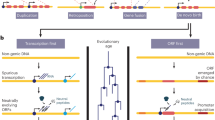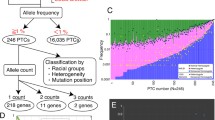Abstract
The comparative study of the human and chimpanzee genomes may shed light on the genetic ingredients for the evolution of the unique traits of humans. Here, we present a simple procedure to identify human-specific nonsense mutations that might have arisen since the human–chimpanzee divergence. The procedure involves collecting orthologous sequences in which a stop codon of the human sequence is aligned to a non-stop codon in the chimpanzee sequence and verifying that the latter is ancestral by finding homologs in other species without a stop codon. Using this procedure, we identify nine genes (CML2, FLJ14640, MT1L, NPPA, PDE3B, SERPINA13, TAP2, UIP1, and ZNF277) that would produce human-specific truncated proteins resulting in a loss or modification of the function. The premature terminations of CML2, MT1L, and SERPINA13 genes appear to abolish the original function of the encoded protein because the mutation removes a major part of the known active site in each case. The other six mutated genes are either known or presumed to produce functionally modified proteins. The mutations of five genes (CML2, FLJ14640, MT1L, NPPA, TAP2) are known or predicted to be polymorphic in humans. In these cases, the stop codon alleles are more prevalent than the ancestral allele, suggesting that the mutant alleles are approaching fixation since their emergence during the human evolution. The findings support the notion that functional modification or inactivation of genes by nonsense mutation is a part of the process of adaptive evolution and acquisition of species-specific features.

Similar content being viewed by others
References
Angata T, Margulies EH, Green ED, Varki A (2004) Large-scale sequencing of the CD33-related Siglec gene cluster in five mammalian species reveals rapid evolution by multiple mechanisms. Proc Natl Acad Sci USA 101:13251–13256
Balter M (2005) Evolutionary genetics. Are humans still evolving? Science 309:234–237
Caputi M, Kendzior RJ Jr, Beemon KL (2002) A nonsense mutation in the fibrillin-1 gene of a Marfan syndrome patient induces NMD and disrupts an exonic splicing enhancer. Genes Dev 16:1754–1759
Carroll SB (2005) Evolution at two levels: on genes and form. PLoS Biol 3:e245
Chou HH, Hayakawa T, Diaz S, Krings M, Indriati E, Leakey M, Paabo S, Satta Y, Takahata N, Varki A (2002) Inactivation of CMP-N-acetylneuraminic acid hydroxylase occurred prior to brain expansion during human evolution. Proc Natl Acad Sci 99:11736–11741
Clark AG, Glanowski S, Nielsen R, Thomas PD, Kejariwal A, Todd MA, Tanenbaum DM, Civello D, Lu F, Murphy B, Ferriera S, Wang G, Zheng X, White TJ, Sninsky JJ, Adams MD, Cargill M (2003) Inferring nonneutral evolution from human-chimp-mouse orthologous gene trios. Science 302:1960–1963
Clark SJ, Harrison J, Frommer M (1995) CpNpG methylation in mammalian cells. Nat Genet 10:20–27
Colonna M, Bresnahan M, Bahram S, Strominger JL, Spies T (1992) Allelic variants of the human putative peptide transporter involved in antigen processing. Proc Natl Acad Sci 89:3932–3936
Cooper SJ, Wheeler D, De Leo A, Cheng JF, Holland RA, Marshall Graves JA, Hope RM (2005) The mammalian αD-globin gene lineage and a new model for the molecular evolution of α-globin gene clusters at the stem of the mammalian radiation. Mol Phylogenet Evol (in press)
Dolphin CT, Beckett DJ, Janmohamed A, Cullingford TE, Smith RL, Shephard EA, Phillips IR (1998) The flavin-containing monooxygenase 2 gene (FMO2) of humans, but not of other primates, encodes a truncated, nonfunctional protein. J Biol Chem 273:30599–30607
Enard W, Przeworski M, Fisher SE, Lai CS, Wiebe V, Kitano T, Monaco AP, Paabo S (2002) Molecular evolution of FOXP2, a gene involved in speech and language. Nature 418:869–872
Evans PD, Anderson JR, Vallender EJ, Gilbert SL, Malcom CM, Dorus S, Lahn BT (2004) Adaptive evolution of ASPM, a major determinant of cerebral cortical size in humans. Hum Mol Genet 13:489–494
Fondon JW III, Garner HR (2004) Molecular origins of rapid and continuous morphological evolution. Proc Natl Acad Sci USA 101:18058–18063
Gilad Y, Man O, Paabo S, Lancet D (2003) Human specific loss of olfactory receptor genes. Proc Natl Acad Sci 100:3324–3327
Goodman M, Grossman LI, Wildman DE (2005) Moving primate genomics beyond the chimpanzee genome. Trends Genet 21:511–517
Gruchala M, Ciecwierz D, Wasag B, Targonski R, Dubaniewicz W, Nowak A, Sobiczewski W, Ochman K, Romanowski P, Limon J, Rynkiewicz A (2003) Association of the ScaI atrial natriuretic peptide gene polymorphism with nonfatal myocardial infarction and extent of coronary artery disease. Am Heart J 145:125–131
Hahn Y, Lee B (2005) Identification of nine human-specific frameshift mutations by comparative analysis of the human and the chimpanzee genome sequences. Bioinformatics 21:i186-i194
Hamann J, Kwakkenbos MJ, de Jong EC, Heus H, Olsen AS, van Lier RA (2003) Inactivation of the EGF-TM7 receptor EMR4 after the Pan-Homo divergence. Eur J Immunol 33:1365–1371
Hawn TR, Wu H, Grossman JM, Hahn BH, Tsao BP, Aderem A (2005) A stop codon polymorphism of Toll-like receptor 5 is associated with resistance to systemic lupus erythematosus. Proc Natl Acad Sci
Hesse M, Zimek A, Weber K, Magin TM (2004) Comprehensive analysis of keratin gene clusters in humans and rodents. Eur J Cell Biol 83:19–26
Huang X, Madan A (1999) CAP3: a DNA sequence assembly program. Genome Res 9:868–877
International Human Genome Sequencing Consortium (2004) Finishing the euchromatic sequence of the human genome. Nature 431:931–945
Kang S, Graham JM Jr, Olney AH, Biesecker LG (1997) GLI3 frameshift mutations cause autosomal dominant Pallister-Hall syndrome. Nat Genet 15:266–268
Kelly A, Powis SH, Kerr LA, Mockridge I, Elliott T, Bastin J, Uchanska-Ziegler B, Ziegler A, Trowsdale J, Townsend A (1992) Assembly and function of the two ABC transporter proteins encoded in the human major histocompatibility complex. Nature 355:641–644
Krawczak M, Ball EV, Cooper DN (1998) Neighboring-nucleotide effects on the rates of germ-line single-base-pair substitution in human genes. Am J Hum Genet 63:474–488
Kumar S, Tamura K, Nei M (2004) MEGA3: integrated software for molecular evolutionary genetics analysis and sequence alignment. Brief Bioinform 5:150–163
Lambert E, Kille P, Swaminathan R (1996) Cloning and sequencing a novel metallothionein I isoform expressed in human reticulocytes. FEBS Lett 389:210–212
Levin ER, Gardner DG, Samson WK (1998) Natriuretic peptides. N Engl J Med 339:321–328
Li T, Duan W, Yang H, Lee MK, Bte Mustafa F, Lee BH, Teo TS (2001) Identification of two proteins, S14 and UIP1, that interact with UCH37. FEBS Lett 488:201–205
Li WH, Saunders MA (2005) The chimpanzee and us. Nature 437:50–51
Liang H, Guo W, Nagarajan L (2000) Chromosomal mapping and genomic organization of an evolutionarily conserved zinc finger gene ZNF277. Genomics 66:226–228
Marsden MD, Fournier RE (2005) Organization and expression of the human serpin gene cluster at 14q32.1. Front Biosci 10:1768–1778
McConkey EH (2004) Orthologous numbering of great ape and human chromosomes is essential for comparative genomics. Cytogenet Genome Res 105:157–158
Miki T, Taira M, Hockman S, Shimada F, Lieman J, Napolitano M, Ward D, Taira M, Makino H, Manganiello VC (1996) Characterization of the cDNA and gene encoding human PDE3B, the cGIP1 isoform of the human cyclic GMP-inhibited cyclic nucleotide phosphodiesterase family. Genomics 36:476–485
Nielsen R, Bustamante C, Clark AG, Glanowski S, Sackton TB, Hubisz MJ, Fledel-Alon A, Tanenbaum DM, Civello D, White TJ, J JS, Adams MD, Cargill M (2005) A scan for positively selected genes in the genomes of humans and chimpanzees. PLoS Biol 3:e170
Olson MV (1999) When less is more: gene loss as an engine of evolutionary change. Am J Hum Genet 64:18–23
Ozaki K, Fujiwara T, Nakamura Y, Takahashi E (1998) Isolation and mapping of a novel human kidney- and liver-specific gene homologous to the bacterial acetyltransferases. J Hum Genet 43:255–258
Pearl LH (2000) Structure and function in the uracil-DNA glycosylase superfamily. Mutat Res 460:165–181
Peneff C, Mengin-Lecreulx D, Bourne Y (2001) The crystal structures of Apo and complexed Saccharomyces cerevisiae GNA1 shed light on the catalytic mechanism of an amino-sugar N-acetyltransferase. J Biol Chem 276:16328–16334
Perry GH, Verrelli BC, Stone AC (2005) Comparative analyses reveal a complex history of molecular evolution for human MYH16. Mol Biol Evol 22:379–382
Popsueva AE, Luchinskaya NN, Ludwig AV, Zinovjeva OY, Poteryaev DA, Feigelman MM, Ponomarev MB, Berekelya L, Belyavsky AV (2001) Overexpression of camello, a member of a novel protein family, reduces blastomere adhesion and inhibits gastrulation in Xenopus laevis. Dev Biol 234:483–496
Powis SH, Mockridge I, Kelly A, Kerr LA, Glynne R, Gileadi U, Beck S, Trowsdale J (1992) Polymorphism in a second ABC transporter gene located within the class II region of the human major histocompatibility complex. Proc Natl Acad Sci 89:1463–1467
Preuss TM, Caceres M, Oldham MC, Geschwind DH (2004) Human brain evolution: insights from microarrays. Nat Rev Genet 5:850–860
Rigby KE, Chan J, Mackie J, Stillman MJ (2006) Molecular dynamics study on the folding and metallation of the individual domains of metallothionein. Proteins 62:159–172
Rubattu S, Stanzione R, Di Angelantonio E, Zanda B, Evangelista A, Tarasi D, Gigante B, Pirisi A, Brunetti E, Volpe M (2004) Atrial natriuretic peptide gene polymorphisms and risk of ischemic stroke in humans. Stroke 35:814–818
Ruvolo M (2004) Comparative primate genomics: the year of the chimpanzee. Curr Opin Genet Dev 14:650–656
Silverman GA, Bird PI, Carrell RW, Church FC, Coughlin PB, Gettins PG, Irving JA, Lomas DA, Luke CJ, Moyer RW, Pemberton PA, Remold-O’Donnell E, Salvesen GS, Travis J, Whisstock JC (2001) The serpins are an expanding superfamily of structurally similar but functionally diverse proteins. Evolution, mechanism of inhibition, novel functions, and a revised nomenclature. J Biol Chem 276:33293–33296
Sonnhammer EL, Durbin R (1995) A dot-matrix program with dynamic threshold control suited for genomic DNA and protein sequence analysis. Gene 167:GC1–10
Stedman HH, Kozyak BW, Nelson A, Thesier DM, Su LT, Low DW, Bridges CR, Shrager JB, Minugh-Purvis N, Mitchell MA (2004) Myosin gene mutation correlates with anatomical changes in the human lineage. Nature 428:415–418
Stennard FA, Holloway AF, Hamilton J, West AK (1994) Characterisation of six additional human metallothionein genes. Biochim Biophys Acta 1218:357–365
The Chimpanzee Sequencing and Analysis Consortium (2005) Initial sequence of the chimpanzee genome and comparison with the human genome. Nature 437:69–87
Thompson JD, Higgins DG, Gibson TJ (1994) CLUSTAL W: improving the sensitivity of progressive multiple sequence alignment through sequence weighting, position-specific gap penalties and weight matrix choice. Nucleic Acids Res 22:4673–4680
Vallee BL (1995) The function of metallothionein. Neurochem Int 27:23–33
Winter H, Langbein L, Krawczak M, Cooper DN, Jave-Suarez LF, Rogers MA, Praetzel S, Heidt PJ, Schweizer J (2001) Human type I hair keratin pseudogene ϕhHaA has functional orthologs in the chimpanzee and gorilla: evidence for recent inactivation of the human gene after the Pan-Homo divergence. Hum Genet 108:37–42
Wu TD, Watanabe CK (2005) GMAP: a genomic mapping and alignment program for mRNA and EST sequences. Bioinformatics 21:1859–1875
Zhang Z, Harrison PM, Liu Y, Gerstein M (2003) Millions of years of evolution preserved: a comprehensive catalog of the processed pseudogenes in the human genome. Genome Res 13:2541–2558
Acknowledgments
This research was supported by the Intramural Research Program of the NIH, National Cancer Institute, Center for Cancer Research.
Author information
Authors and Affiliations
Corresponding author
Electronic supplementary material
Rights and permissions
About this article
Cite this article
Hahn, Y., Lee, B. Human-specific nonsense mutations identified by genome sequence comparisons. Hum Genet 119, 169–178 (2006). https://doi.org/10.1007/s00439-005-0125-6
Received:
Accepted:
Published:
Issue Date:
DOI: https://doi.org/10.1007/s00439-005-0125-6




